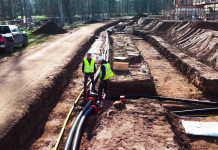 Heatpumps, CHP and biomass dominate the list of heating technologies being explored or installed by readers of The Energyst.
Heatpumps, CHP and biomass dominate the list of heating technologies being explored or installed by readers of The Energyst.
Surveyed for a new report on decarbonising heat, 81 people completed the survey across sectors spanning manufacturing, health, local government, central government, leisure and retail. Respondents also included consultants working across multiple sectors.
The survey found that three quarters of respondents (76%) are assessing lower carbon heating solutions.
Around 50 respondents specified which technologies they were deploying or considering. Of those, 44% are assessing or deploying more than one type. A handful of others said they were assessing all options or that choices were dependent on client suitability.
By volume, survey data shows that readers are most interested in heatpumps, with 19 respondents stating they are either considering deployment or are deploying the technology, most of which were air-source where specified. Combined heat and power was the next most popular technology, cited by 16 respondents, followed closely by biomass (15).
Respondents are also either deploying or investigating: waste heat recovery (4); condensing boilers (3); solar (3)*; solar thermal (3); heat networks (2); BMS/controls (2); energy from waste (2); infrared panels (1); geothermal heat (1); fuel cells (1); and nanopartical technology (1).
A briefing to launch the report yesterday found strong support for waste heat to be harnessed and given some form of support. Currently the Renewable Energy Directive states that man-made waste heat cannot qualify for renewable support.
Association for Decentralised Energy boss Tim Rotheray told delegates that the UK was pushing Brussels for changes to that rule, but “was the only member state of 28 doing so”.
However, as the Commission has announced a major push on heat this year, alongside a review of the Renewable Energy Directive, there is some chance that lobbying efforts may pay off. Rotheray said there was enough “waste heat in the UK to heat every home 1.5 times over”.
Without policy to capture waste heat, he said, decarbonising the sector would not be achieved at lowest cost.
The new heat report is free to download. It contains full survey results on attitudes to heat, support schemes and technologies. As well as an overview of market challenges, the report also includes qualitative interviews with respondents, spanning subjects from heat network finance to heat storage.
Download your free copy here.
*As responses to this question were open-ended it may be that solar actually refers to solar thermal, more commonly used than PV for heat.
Related stories:
Free report: The heat report 2016
European Commission turns focus to energy efficient heat
Renewable heat subsidy schemes ‘wasting money’ by ruling out waste heat
75p/kWh subsidies for district heating?
Decentralisation the key to heat networks?
Tim Rotheray: Put users at heart of energy policy or watch it fail
CHP behind 6% of UK electricity, could do more
Councils step up heat network plans
Firms with CHP generators could be paid to stop exporting power
Local Authorities say finance and public procurement biggest barrier to heat networks
Free report: Financing energy efficiency
Free report: Demand side response
Free report: 2016 business energy risks
Click here to see if you qualify for a free subscription to the print magazine, or to renew.
Follow us at @EnergystMedia. For regular bulletins, sign up for the free newsletter.



